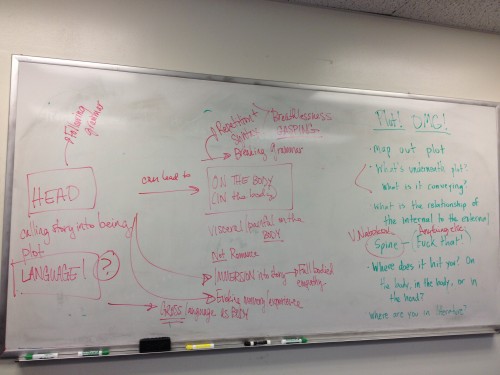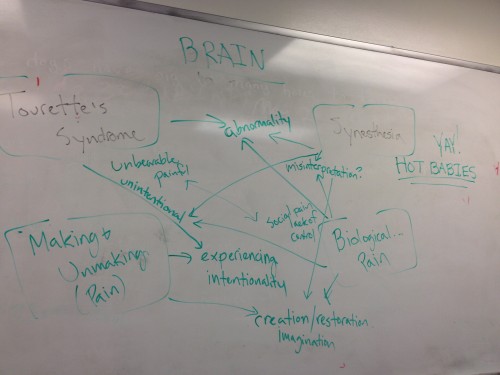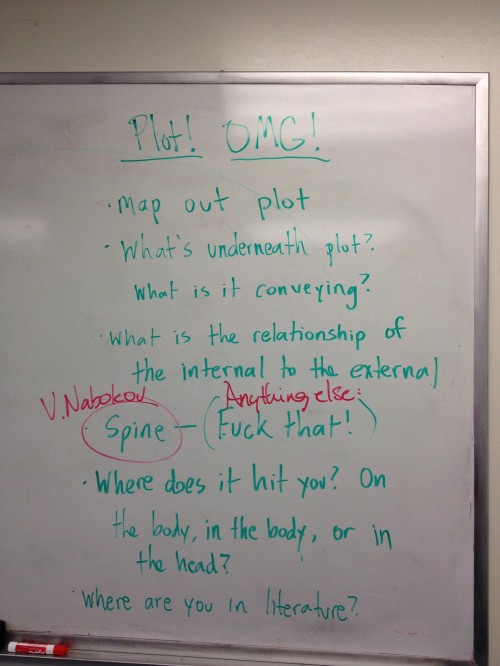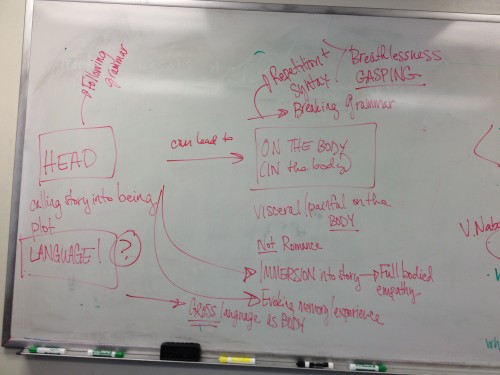in which Lily teaches a class on a whiteboard
This is what happened in my grad Form & Technique in Fiction class today:
 Here is how it happened. Every Wednesday, students read articles and essays that are NOT fiction. Last class, they read & we discussed a unit I called “The Human Body,” which included the following texts: Dong et al, “Unilateral Deep Brain Stimulation of the Right Globus Pallidus Internus in Patients with Tourette’s Syndrome”
(from The Journal of International Medicine); Grahek, Feeling Pain and Being in Pain, “Ch. 1: The Biological Function & Importance of Pain”; Ramachandran, Tell-Tale Brain, “Ch. 3: Loud Colors and Hot Babes: Synesthesia”; and
Scarry, The Body in Pain, “Ch.3: Pain and Imagining.”
Here is how it happened. Every Wednesday, students read articles and essays that are NOT fiction. Last class, they read & we discussed a unit I called “The Human Body,” which included the following texts: Dong et al, “Unilateral Deep Brain Stimulation of the Right Globus Pallidus Internus in Patients with Tourette’s Syndrome”
(from The Journal of International Medicine); Grahek, Feeling Pain and Being in Pain, “Ch. 1: The Biological Function & Importance of Pain”; Ramachandran, Tell-Tale Brain, “Ch. 3: Loud Colors and Hot Babes: Synesthesia”; and
Scarry, The Body in Pain, “Ch.3: Pain and Imagining.”
Here is a “map” of that class discussion:
Last Wednesday, we talked about the corporeal v. the imagination as modes of description. During class discussion (ok, I rudely interrupted the super fly presentation you see above), I asked the class to write a paragraph on “pain,” esp. based on all these things we’d just read and were actively talking about.
I wanted a bodily response.
I wanted pain.
So they wrote, and I asked them to talk about it (talk, as in talk about the process and the thing itself, without reading it out loud) and most of the students wrote 1st person present accounts of pain they’d experienced. They started with sense (seeing what will become painful), moved to the cerebral (the moment when the head realizes that pain will come to the body but it hasn’t yet arrived), and ended on the body (mostly using metaphor to describe pain). Almost my entire class did a variation with this narrative frame.
I don’t know what I learned or what I taught or what my students learned, but I came up with some basic understandings:
1. There is a relationship of causality between pain, our senses, the cerebral, the body, and metaphor. The way each of these items is weighted determines causality. This is probably obvious, but it came something like an epiphany to me;
2. Post-Spinoza, I’m not sure people even care about the mind-body split anymore. But maybe we should. I’m not picking an argument with Spinoza’s Ethics—I ain’t that dumb, well, maybe in other ways—but I think we should look at the relationship between mind and body, especially in terms of writing, because there is a huge difference between cerebral writing (I’m thinking here of someone like Joshua Cohen, who I think of as a master architect of glassine hyper-evolved sophisticated sentences, extravagant objects that tickle—and maybe masturbate—the brain) versus passionate writing (I’m thinking here of someone like Lidia Yuknavitch, whose emotionality shreds the reader’s body. Yes, there are times when her emotion can dive into the “sentimental”—naughty, naughty, writer. We must never be sentimental. It’s the most insulting of workshop insults! Haven’t you learned?!—but to me, that passion is worth any critique, any messiness in language, that passion is the whole fucking point of anything.);
3. According to Elaine Scarry, “pain” is objectless, that is: there is no objectification of pain, no thingness to it, only approximation of location, which is hardly the same thing. According to Scarry, “pain” can lead to “imagination.” A body so pained is forced into imagination as the only possible—though self-consciously only a temporary fix—respite. Imagination is where pain can be objectified. Imagination is the escape;
4. My head hurts, putting all this together; and
5. Unrelated to class, but in order to understand my current situation of life-in-crisis—and maybe because Jackie Wang puts dangerous seeds in my head—I’ve been reading a ton of theory about friendship and passion and affect (e.g. Lauren Berlant, Agamben, Foucault, Derrida, Butler, and a lot more). I mean, it’s been a heavy month.
NOW back on track: So based on the readings/discussions, students generate creative work to be “mini-workshopped” on Mondays (like today). During these mini-workshops, I give my students some aspect of “craft” as the lens (e.g. place, dialogue, character, plot) to talk about what they’ve written. Today, we talked about PLOT. My student Phil cleverly put “OMG” next to it because, well, I’m not really a plot person I guess. Or maybe that’s just my reputation. The assignment was to divide into pairs and map out the plot of each other’s story. Then, looking at the map, consider what the story is actually working towards. I wanted them to see how the plot was just something draped over to get at something else. I asked them to think about where the story hits them as a reader: in the body, on the body, or in the head? [I did not tell them that stories can hit all three marks. I hoped someone would ask me about it, but no one did, so I let them think that these three things are mutually exclusive. Obv, they aren’t, but that’s for another day maybe.]
Here are the instructions:
Before I released them to go “workshop” and map stuff, I talked about Nabokov, how he said good stories hit him in the “spine.” We’ve all heard that one. So I read them some contemporary lit, asked them where these passages “hit” them: in the body, on the body, or in the head. I read passages by: Marie Calloway, Joshua Cohen, Tao Lin, Peter Markus, Lance Olsen, Susan Steinberg, and Lidia Yuknavitch.
Then, they went and talked and mapped and workshopped and came back.
Here is the discussion board after they looked at each other’s works based on my criteria for “plot”:
We ended class more than five minutes late because we got all into talking about my false binary of “head” v. “body” (because I don’t actually value “body” over “head,” I think they are both necessary, both urgent, both impacting) and about how writing moves from one category to the other and back. We talked about syntax and grammar and rules and I walked away confused and elucidated, like I’d taught something and learned an exponential amount more, like this is the mess teaching can become and it’s such a glorious event, my dizziness, thinking on this crazy thing I love: storytelling.
[Note: Thank you to my Form & Tech class for rolling with all this. I can’t imagine what I’d think if I were a student, but from my end of things, it’s rather a blast. I walk away from every class spinning and feral from our discussion. So, sincerely, thank you.]




i take photos of my classroom whiteboard all the time
and they alwaysalwaysalways have those reallyannoying unaestheticallypleasing hotspotglares
ps – i didn’t read any of your post, sorry
oh, and re: “head” v. “body” (cuz i just peeked a bit at yo post) in The Tenant Roman Polanski’s character says “What right does my head have to call itself ‘me’?”
You might want to add that to your syllabus Lily.
Jesus, it’s not fair.
Here’s an interesting quote for you:
“The first three pages of “Proprioception,” written six years later & easily Olson’s most ambitious & successful critical project, show O working through this problem, this question, at great length. He is so concerned with place that he is driven to find such, somewhere. Proprioception itself, kinesthesia, one’s awareness of the actual physical rubbing together of one’s inner organs, the growl of the stomach & peristaltic pulse of the bowels, is for Olson a key, an awareness that precedes any other mode of knowing – “I am I because my little gut knows me.” The body for Olson is the place of the unconscious. The “soul,” an entity with which Olson was much obsessed, proved to be profoundly physical. Projection – the meat of his practice as a writer, a (literally) Projectivist poet – ‘is discrimination (of the object from the subject) and the unconscious is the universe flowing-in, inside.’ ”
http://ronsilliman.blogspot.hu/2003/03/rob-stanton-has-some-follow-up.html
Do you remember what the consensus was for where the contemporary lit “hit” most?
Really interesting. Whiteboard maps are pretty.
Mostly the “head,” some ON the body, fewest IN the body (or, Nabokov’s “spine”)
Thanks, Mimi!
It was a LONG post. Don’t blame you at all, but pictures are pretty, minus the glare, ugh.